Written by Hyeonseo Heather Park, a work placement student from MLitt Art History at University of Glasgow.
Conducting private research for a collection of material on William Meldrum provided a rewarding experience. Meldrum, was a Scottish artist famous for capturing aesthetically pleasing natural scenes on canvas; he joined the Glasgow School of Art as a student from 1883 to 1892, when his attendance overlapped with the period during which many of the Glasgow Boys were at the school. Following Meldrum’s footsteps within Glasgow has not only shed light on the artist’s life but also on the history of the Glasgow School of Art and Scotland of the past.
Scenic Views of Scotland Through Meldrum’s Paintings
The William Meldrum collection includes photographs of his watercolour paintings, which depict various landscapes across Scotland as well as Glasgow and its flourishing days. One remarkable aspect of his artworks lies in the handwritten annotations often found on the reverse. Such annotations provide approximate viewpoints from which Meldrum likely captured the scenery.
For instance, “Photograph of the Cuillin Hills view” (Figure 1) is annotated “Loch Scavaig, the Cuillin Hills from the south.” It suggests that Meldrum may have painted the landscape from the Cuillin Hills on the Isle of Skye, near the bay of Loch Scavaig, located to the south of the hills. Such annotations, gleaned from photographs of his paintings, offer valuable sights into the probable locations depicted in his works.
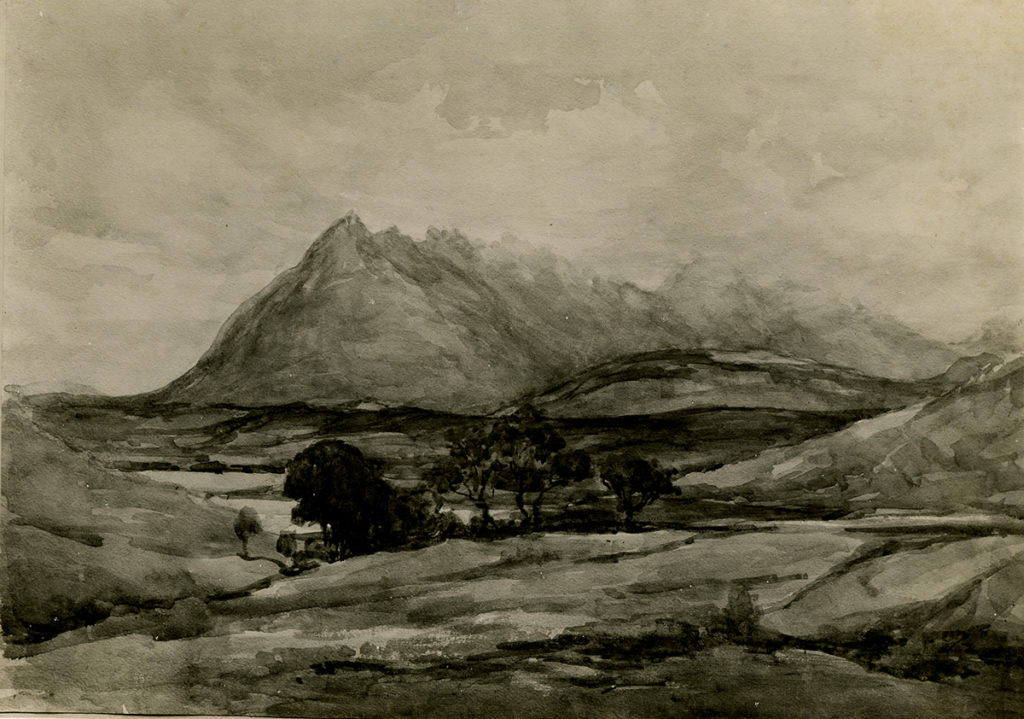
Likewise, “Photograph of a bay view painting” (Figure 2) features a tranquil and serene moment in Gourock, a coastal town in the West of Scotland. An annotation on the back of the print reads “Gourock at the Clyde,” indicating that the view was painted from the upper Firth of Clyde nearby.
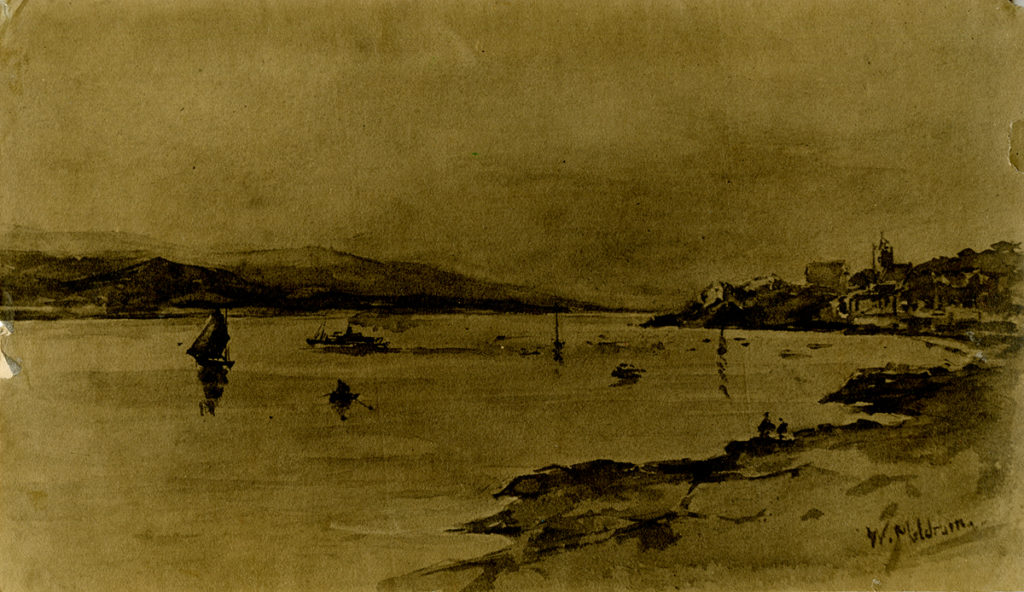
Figure 2. William Meldrum, Photograph of a bay view painting, c1890s-1920s, photograph, 100 x 175mm, DC 120/2/2.
Taking into account that most of these photographs are not precisely dated, it is possible that the annotations and photographs of the paintings were made by James Meldrum, the artist’s son, who inherited his father’s works according to his will. Despite this possibility, the restrained brushwork and consistent style across the collection suggest a unified series, enhancing the tranquil and captivating qualities of the works.
Meldrum’s Contribution to Shaping Art History of Glasgow
According to the materials regarding the retrospective exhibition of Mackintosh and Margaret MacDonald at McLellan Galleries in Glasgow in 1933, many of the displayed artworks resulted from the collaboration with the Meldrum Collection managed by James Meldrum (Billcliffe 1993, 3-9). It is said that William Meldrum and Mackintosh attended evening classes at the GSA for several years out of the same decade of the 1880s. It is estimated to have started in 1885 when Meldrum changed his learning from regular classes to evening sessions, and Francis H. Newbery began to perform the role of a headmaster at the school. Also, both artists’ overlapped attendance were likely continued until 1889, when Meldrum temporarily left the school for a year. It is speculated that Meldrum and Mackintosh may have had an acquaintanceship. Thus, some of Mackintosh’s works could be acquired by Meldrum for his private collection and therefore, could have significantly contributed to preserve a pivotal aspect of Glasgow’s artistic history.
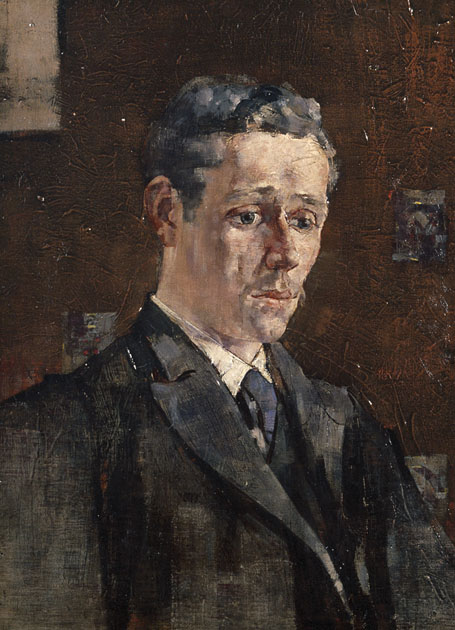
In addition to Mackintosh, Meldrum befriended several of the Glasgow Boys, artists with whom he shared an artistic environment in Glasgow during the same period. It is assumed that he had a close relationship with John Quinton Pringle (1864-1925), as seen in Pringle’s portrait of Meldrum, created around 1890(Figure 3).
As Meldrum recorded, Pringle dedicated three summer months and two hours each morning to painting “The Loom” (1891) (Hardie 2010, 157-158). This suggests that the two artists were close friends and engaged in artistic exchanges during this time.
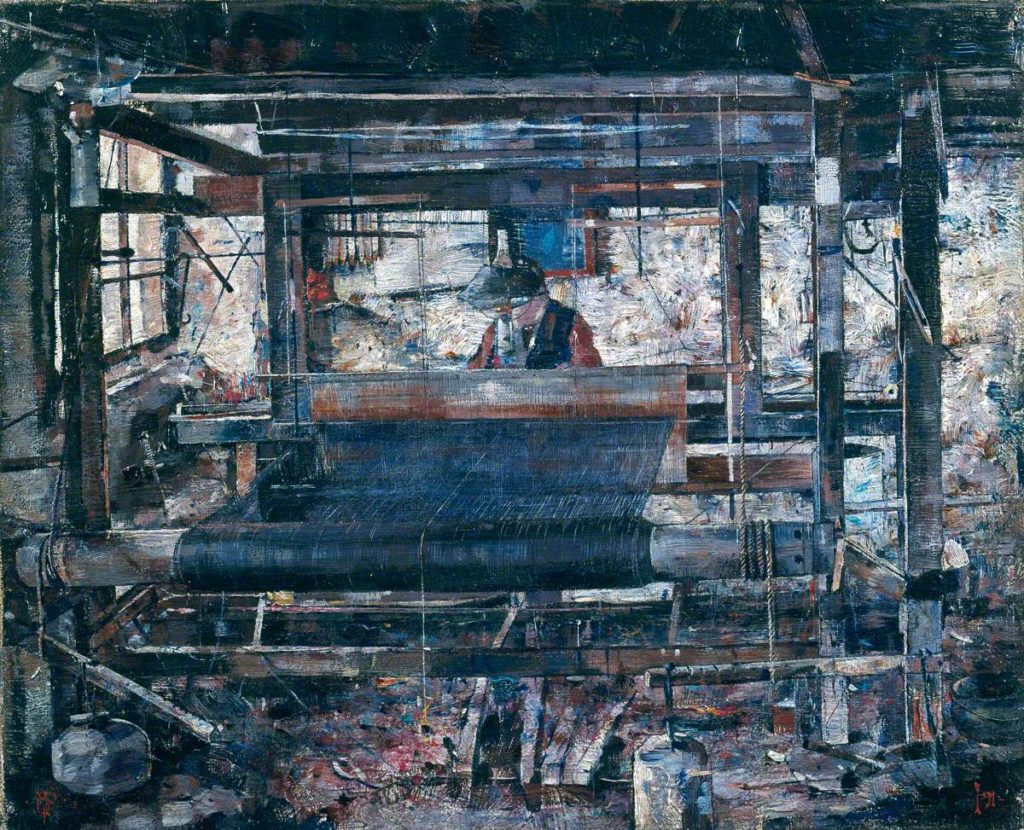
Depicting the Serene landscapes with Houses
In addition to natural scenes, Meldrum used to paint castles, mansions, and manses, the traditional Scottish clergy houses. Even if he could be described as the artist associated with the Glasgow Boys; he took a slightly different route to them. While the Glasgow Boys had a tendency to paint mundane scenes, specifically ordinary people’s everyday lives, Meldrum largely concentrated on more naturalistic and idyllic moments, from small Scottish villages to the peaceful landscapes of the Isles.
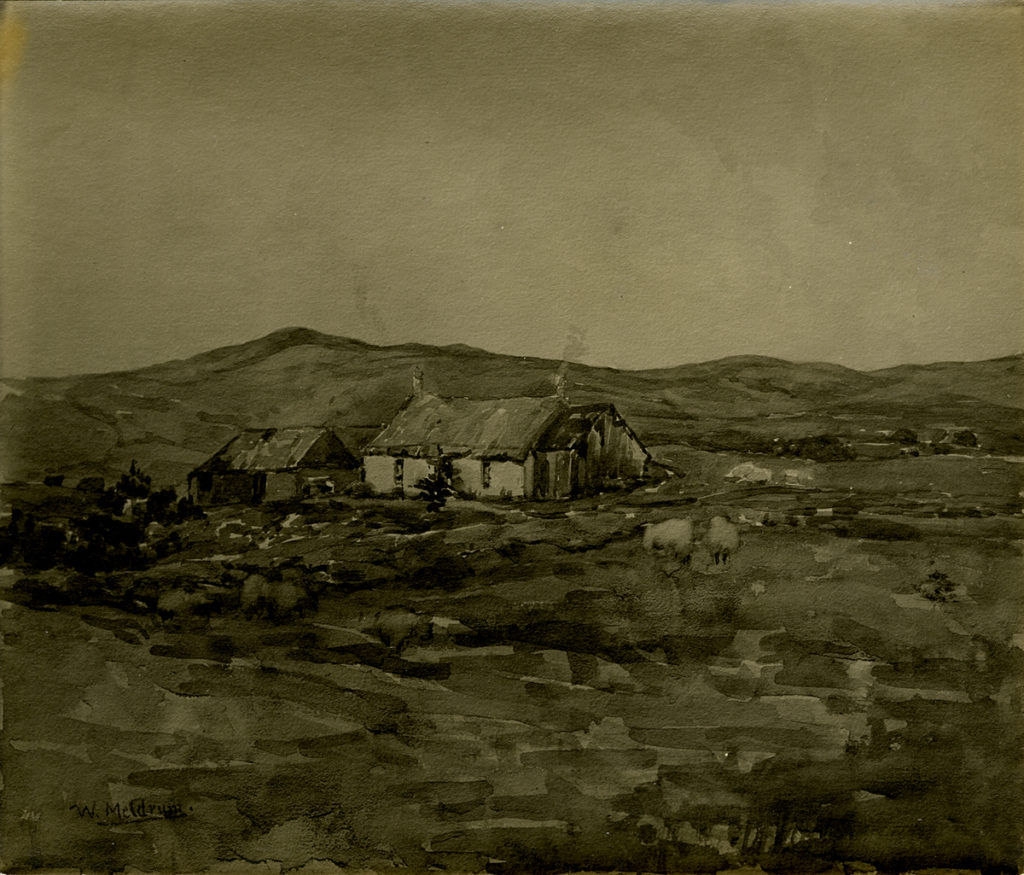
As depicted in ‘Photograph of a Country House Painting’ (Figure 5), the idyllic landscape evokes a sense of tranquillity and serenity. Although the original watercolour painting now exists solely as a photograph, the peaceful, pastoral ambiance it conveyed remains intact.
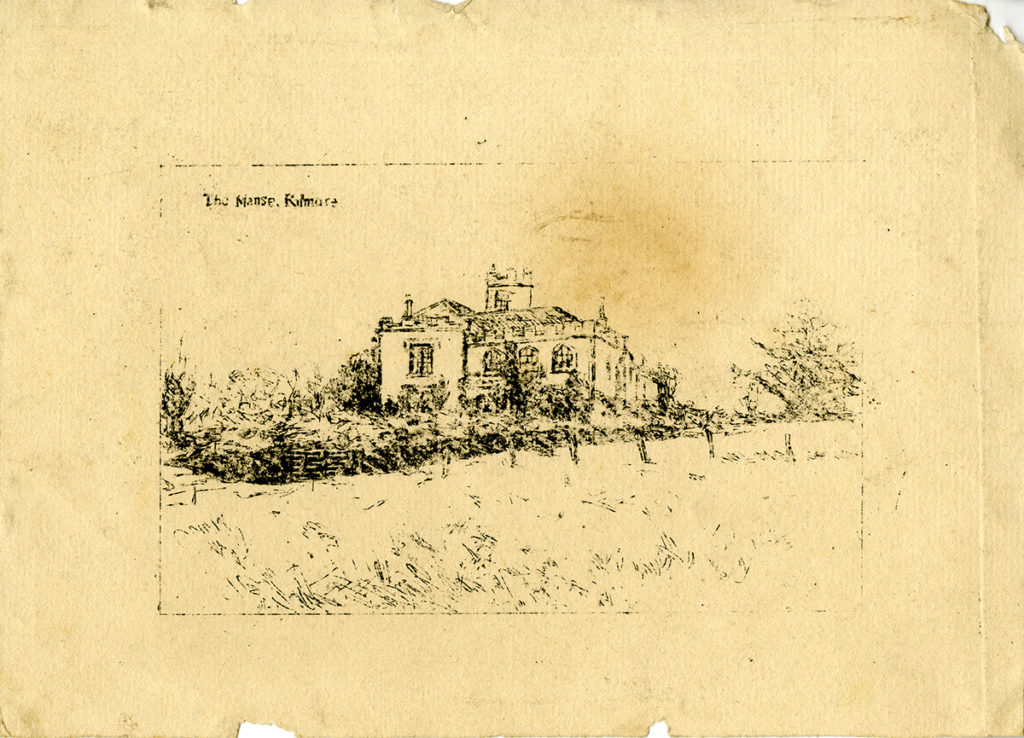
The ‘Drawing of a Manse,’ portraying the residence of a minister’s family in the Scottish Presbyterian Church, evokes the sensation of peeking into the artist’s travel journal. Through this print work, we can also immerse ourselves in the serene atmosphere that the artist would have experienced while exploring Kilmore. Meldrum seemed to particularly enjoy capturing moments of tranquil landscapes on his canvas.
Playful Artwork Using Seaweed
In his later years, Meldrum created intriguing artworks using dried red dulse and kelp seaweed collected on the shores of the village of Millport in Ayrshire. While craft arts made of natural materials are somewhat commonplace today, undertaking such a pioneering and playful challenge as early as 1936 makes Meldrum worthy of being considered an innovative artist.
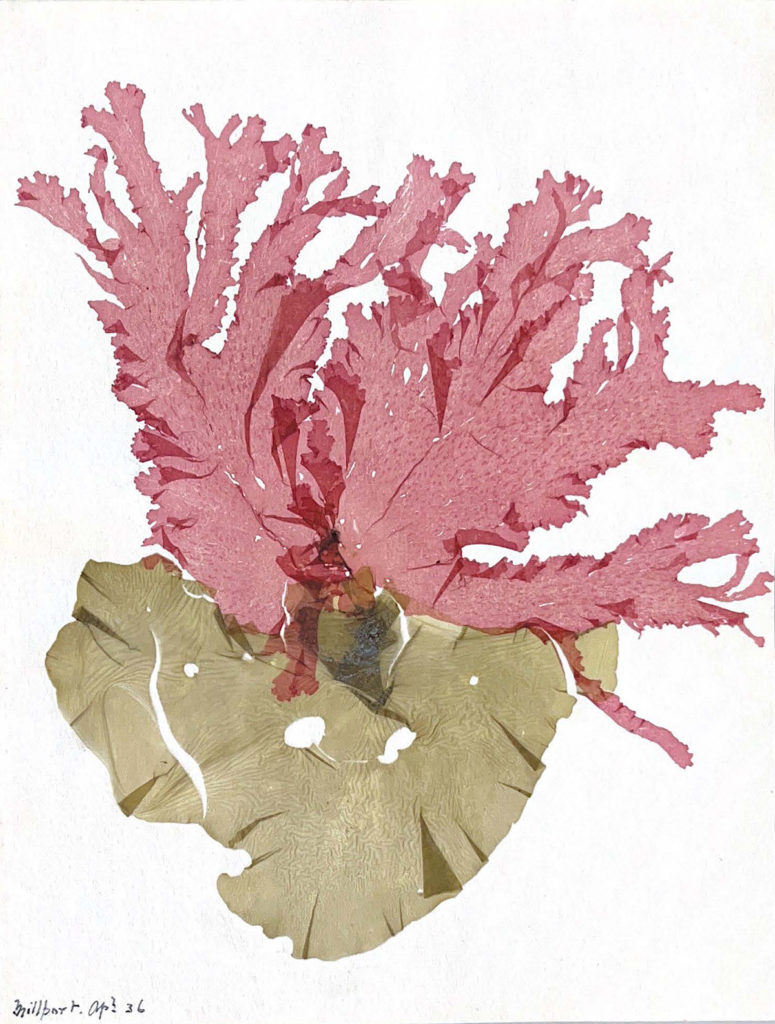
The GSA Archives & Collections has accessioned two pieces made of seaweed, both presumed to belong to the same series. The natural materials is still attached to the paper, retaining their organic shapes despite the inevitable fragility that comes with time. The part to which the red dulse was affixed resembles floral petals, while the brownish-green seaweed forms appear to be branches or leaves. Refer to DC120 on GSA Archives & Collections on-line catalogue for further exploration of Meldrum’s stories shaping Scotland of yesterday.
Bibliography
Billcliffe, Roger. Charles Rennie Mackintosh: Textile Designs. San Francisco: Pomegranate Artbooks, 1993: 3-9.
Hardie, William. The Glasgow Boys in Your Pocket. Glasgow: Waverley Books Ltd., 2010, 157-158.
Glasgow Life, n.d, “The Meldrum Collection,” ©Glasgow Life 2018, https://libcat.csglasgow.org/web/arena/meldrum.
Glasgow Museums Resource Centre, n.d, “painting / William Meldrum 1865-1942” by John Quinton Pringle, courtesy of Glasgow Museums Collections. https://collections.glasgowmuseums.com/mwebcgi/mweb?request=record;id=1434;type=101.
